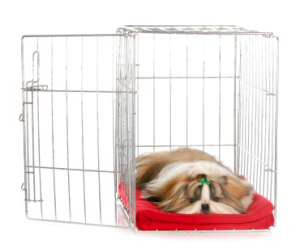 Over the past decade or so, dog crates have become a must have piece of equipment for all dog owners. Trainers and pet stores have done a great job at promoting its use and most dog lovers today have adopted the idea that using a dog crate is a positive and humane teaching tool. But is it always? Has the promotion of dog crating gone so far that we’re desensitized to some of its downfalls? Just like any other teaching aid, there is a tipping point between welfare and abuse.
Over the past decade or so, dog crates have become a must have piece of equipment for all dog owners. Trainers and pet stores have done a great job at promoting its use and most dog lovers today have adopted the idea that using a dog crate is a positive and humane teaching tool. But is it always? Has the promotion of dog crating gone so far that we’re desensitized to some of its downfalls? Just like any other teaching aid, there is a tipping point between welfare and abuse.
Teaching a dog any behavior is the process of creating conditions that will facilitate the development of certain habits over others. In other words, if you want to teach Fido to potty outside, it works best if while rewarding him for relieving himself in the backyard, you also prevent him from using the carpet as a peeing pad. With that simple principle in mind, using a crate to confine the dog when we cannot supervise him definitely helps in the process. Since most dogs have a natural tendency to avoid soiling the area where they sleep, using a dog crate allows better control of the timing and locations of the puppy’s potty needs. For more information on the subject of potty training you can refer to the following post: ‘Easy potty training instead of housebreaking‘.
Some people still see crating dogs as a form of animal abuse. The idea of confining a dog to such a small space can be disturbing for many. Understandably, the idea of being confined in a box just big enough for us to lie down and turn around seems like a traumatic experience. But if we compare the living situations of early or modern humans with those of wild canids there is a striking difference. Humans look for large caverns, build shelters and homes large enough to move around and house a family. Wolves, coyotes and foxes will ignore a large cavity in the hills and prefer digging their own den, just large enough to curl up. The same way, we like to lie on beds or couches, when dogs often chose to sleep under the living room table or in small corners. In my house for instance, dogs are allowed on the furniture, but my 80 lb German shepherd loves to sleep in one of our closets. It’s dark and confined, and the last place I would want to be, but that’s where she feels comfortable.
When introduced properly, allowing the dog to develop a sense of security in the crate, versus being shoved and forcefully locked in, dogs truly appreciate the den-like sensation that a crate will provide. I have witnessed hundreds of dogs choose to go to their crate on their own when looking for a place to rest. On the flip side, I have also seen dogs panic to the point of destroying their crate and owners simply buying stronger and stronger crates, never addressing the dog’s emotional angst.
Just like anything else, even when the dog likes their crate, there comes a point where the dog crate can become an abusive prison. The predominant question is about confinement in general. Restricting the dog’s ability to choose where and when to move around can be tolerated by the animal, but only to a point. For example crating a dog at night, when it would have slept for 8 hours anyway is more natural. But, crating the dog 8 hours a day, everyday, is a different situation from the dog’s perspective.
So what’s the tipping point? With puppies, crates are fantastic options to help them develop good habits, stay safe from chewing dangerous items and providing them with a comfortable space, as long as we don’t confine them for longer than their bladder can hold, which for the youngest, could be less than 2 hours during the day. As a rule of thumb, dogs of all ages shouldn’t be locked up for more than 2-4 hours at a time during the day. Their need for activity and play simply builds up the longer they’re confined and their feeling of comfort can turn into frustration and anxiety.
As the puppy grows up, has developed strong potty habits, and grown out of his
need for chewing everything in sight, the need for a crate should gradually subside. Adult dogs do not need to be locked up in their crate at all when they’re at home, or only on special occasions. When adult dogs are still crated all day, it’s generally because they still either potty indoors or tend to be destructive in the absence of the owner. In either case, crating has become a crutch for unresolved behavior problems. The dog may be anxious or bored when left alone for extended periods of time. When most of us have to work long hours, the dog pays the price of solitude. In those cases, crating only solves the problem for the owner, not for the dog. In the crate, the dog will no longer be able to pee on the carpet or destroy the owners’ favorite pair of shoes, but his anxiety and boredom have not been addressed. In fact, the long crate hours could have become a contributing factor to his separation anxiety. Working with a trainer on the underlying causes of the behaviors can solve the problem for years to come. Finding a dog walker, a daycare, along with other creative ways to keep the dog busy and happy require a little more effort at first, but can make a significant difference for the dog.
Just like any other device that restricts the animals’ freedom of movement, like a leash or a tether, dog crates can be a den or a prison for the dog. It all depends how we use them and for how long. They can help the owner when establishing specific habits of behavior and give a sense of safety and comfort to the dog. But their overuse can truly develop frustration and feelings of helplessness in the dog. Just like anything else, getting professional help and understanding the proper use of crates can make a world of difference for both dog and owner.
Jennifer Cattet Ph.D.
Related articles







I am not a fan of crates. Yes, I used one when we adopted a dog to allow the dog some comfort, to de-stress to a new environment, to learn daily routines, etc. However, given the option, our dogs prefer to be with their humans. No closet or crate for them. They are crammed on the couch, in chairs, and in bed with us. Their requirement…to be touching a human. The crate–in the closet. We do pull it out occasionally to make sure they remember the “crate” command for emergencies or whatever reason it may be required.
During the day, while we do not know what they do (they free-roam), it is assumed that they nap. I know when I have been home sick, they spend a majority of time in one of the bedrooms, on a bed or in a chair, with a good view outside. While they are stuck like glue to us the rest of the time, when home during the week, they have their own routine. Having said all of that, I am not sure that spending the day in a crate is all that horrible. If the crate is a good size to allow for movement and stretching out, and the dog receives exercise and people time when his/her owners get home, I feel it isn’t all bad.
There are extenuating circumstances for everything and no right or wrong answer. Since the dogs cannot tell us if they hate the crate during the day, why chewing the shoe was the right thing to do, and so much more, we base a lot of it on personal feelings and assumptions. When the dogs start talking back, then a lot of things will require a new approach!
Are dogs den animals? http://www.petmd.com/blogs/fullyvetted/2010/january/dogs-arent-den-animalsso-why-do-we-crate-them#.UgI0UdId40M
I don’t think I could potty train a puppy without a crate. I am careful not to crate for more than 4 hours at a time. On the very rare occasion I have to leave Pepper home alone (maybe twice a year), I do crate her. This is more for my peace of mind than for any behavioral issues. Poms have fragile legs that can be broken if they jump off furniture the wrong way. Pepper has steps/ramps for the furniture, but what if…? The “what if?” is the reason I use the crate these days. The crate keeps her safe.
I have three small dogs, one is still a puppy and I never crate them. One was crated at the vets after surgery but that’s it. I have met so many people who crate their adult dogs all day while they are at work and then again all night and again when they have company, it’s sick and even sicker is they see nothing wrong with it!
I have been told I am irresponsible for not crating my dogs which to me is BS. My dogs don’t destroy my stuff, they don’t eat things they shouldn’t. My dogs don’t need a place to hide as there is nothing here to hide from and the few times they got spooked on walks they ran behind me. When the puppy experienced her first thunderstorm she stopped dead in her tracks and looked to me, I threw her a toy and that was that. When my girl was unwell my lap is where she wanted to be not a crate! I think I would feel like a failure if my dogs felt safer in a cage then with me.
Hi, thanks for sharing.. we can definitely educate our customers who buy dog cages from us.. take care and keep it up..